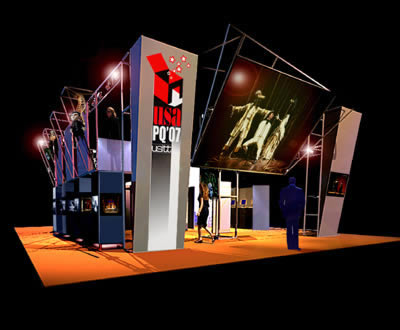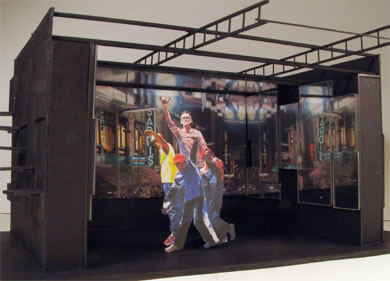 |
 |
 |
|
 |
The United States National exhibit, depicted at left, will be part of the 2007 Prague Quadrennial. It will then be available for touring to venues within the US. To learn how to host the national, student, and architecture exhibits, contact Robert Scales at rscales@usc.edu.
|
|
|
Three Exhibits for 2007 PQ
Taking Shape Now National Exhibit The daunting and incredibly difficult task of representing visual and sound design in the United States in the last four years was the challenge for the USITT PQ 2007 United States National Exhibit team of curators Ursula Belden, David Budries, Laura Crow, Michael Lincoln, Madeleine Sobota, Susan Tsu, and Nic Ularu. Seeking design submissions via the internet, traversing the country in search of exciting productions, blanketing members of USITT and United Scenic Artists with postcards and announcements, incorporating designs from Design Expo, and cajoling personal contacts all became a part of the process. Over 400 submissions were received and just over 100 scenic, lighting, costume, and sound designs were selected to present the concept of "New Voices, New Visions: Out of the Box." The curators endeavored to identify the work of theatre artists who have redefined the art and pushed it to its limits through unique visions and impeccable techniques. "New" could be defined as form or content, creative technology, or contemporary issues in recent scripts. The new voices come from those designers who have had the courage and imagination to break away from traditional practice to create work to surprise, delight, or even disturb. Other new voices included companies and designers working in non-traditional venues using alternative theatre styles. The new visions come from those who are taking risks, looking to the future, and making imaginative and exciting choices to create a new, vibrant American theatre that embraces humanity and touches lives in ever more meaningful ways. The designs represent the cross section of possibilities in the country from award-winning and internationally-renown For the USA National Exhibit, Nic Ularu and Madeleine Sobota recognized the challenge of designing an exhibition for designers, and wanted to evolve a structure that would present the works in an artistic form relating to the contemporary designs contained within. They created a fresh, dynamic, and open configuration that reflects and embodies both the theme and the innovative work selected. The shape of the exhibit itself is a metaphor -- not content with formal and straight lines, the walls burst out at angles, the entrance towers push into vertical space, the installation of costumes explodes like a mushroom cloud. The exhibit is now "Out of the Box!" The exhibit design will lead the visitor on a journey, engaging him or her in new and exciting ways using technology to create a personal experience for each visitor. The entrance features a movie of design images projected on a huge angled screen that is the lid of the box. Inside, interactive video and sound stations provide the viewer with greater access to images and words that tell the story of each design. Designs will additionally be presented in models, renderings, and photos, and installations of costumes and puppets. The curators and exhibit designers share a vision of an inspiring exhibition housing American theatre design that embodies the most innovative, imaginative, and thought-provoking work being produced in the United States today. Student Exhibit The student exhibit for PQ 2007 will be a larger and more complex installation than anything the group has previously mounted. Several areas for featuring designs were created in the exhibit including a gallery of mirror-faced display cubicles to be assigned to each of the participating schools, a monitor and headphones for sound design, a wall of collaged design material representing the diversity of design programs across the country, and a display of three dimensional artifacts such as costumes, jewelry, armor, and props. Below is the 2007 Student Exhibit design by Ursula Belden.  Building on the theme for the National Exhibit, the Student Exhibit theme of "New Voices, New Visions, New Vocabularies" guided the curators in making their selections. "New" at times meant non-traditional while at others meant a unique voice or a new way of doing an old play. Teachers must dream a future they will never see while training their students based on their own pasts. That students excel when the expectations are high is a given, and those programs in which daring teachers inspire their students to take risks will stand out in this exhibition. Risk and experimentation are not all, however. Students must deeply examine their social, political, moral, and spiritual views along with their artistic aesthetic while honing the communicative techniques of the designer. The curators sought designers whose schools appeared to encourage self-knowledge, had sound process and research, and had work that said something with rigor and integrity. In recognition of the ephemeral essence of theater and to encourage student participation, the Student Exhibit will also contain a performance space. The intent of the performance pieces is to be design driven rather than actor/director driven. They can use one or more performers and must be blocked within the PQ student exhibit space, approximately 11 feet deep by 14 feet wide by 9 feet high, with a projection surface at the back and several entrances. The pieces should communicate an idea, explore a theme, or tell a story through visual images and design, springing from the visual imaginations and world of the designer. A minimal lighting system, a projection system, and a portable CD player will be available. Performance pieces can be a maximum of 10 minutes in length and will be presented daily during the PQ Expo, June 14 to 24. During the times when there is no live performance, a DVD loop showing all submitted performance pieces will be projected on the rear screen. To create a video/DVD of a performance for submission, simulate the actual performance space size and characteristics described as much as possible. DVDs should be created in either as .mov, .avi. or .mpeg. Imovie is also compatible. Each school must submit two versions of the recording, one in 4:3 format and one in 16:9 format. Both recordings can be on one DVD. In making the DVD, use a larger file size (around a gig or larger) to guarantee the highest quality (nothing over 50 gigs). For more information, contact Jon Savage at jcsavage@bu.edu. The deadline for entries is November 15 and should be sent to Jon Savage, 2 Ridge Road, Winchester, MA 01890. In conjunction with the PQ exhibits, the Scenofest will feature a wide range of related activities, seminars, workshops, and performances. Students from around the world are invited to prepare designs for The Birds to submit for consideration for display in Prague. If selected to appear in Prague, The Birds projects participants have the opportunity for a critique from international design practitioners and educators. Teachers wanting to assist their students with this project are encouraged to include designs for The Birds in their curriculum this fall. Applications to participate are due in October. For more info on this and other exciting opportunities, go to www.scenofest.org/index.html. Architecture Exhibit A third exhibit of architecture is in the process of being curated now. Headed by Richard Pilbrow, the team has chosen a theme of " Performance Spaces for a New Generation: Training Facilities for the Performing Arts in the United States." The number of training facilities located at schools in this country is one of the aspects that distinguishes American theatre architecture in the world arena. In carrying on the themes of focusing on the new and the future in the other two exhibits, the examples of architecture will include university and college facilities, theatres, schools, and performing arts centers that include specific training programs. To see the complete lists of schools, designers, and productions selected for the USITT PQ 2007 United States Exhibits, go to pqusitt.okstate.edu. To increase the impact of all three exhibits and to reach a wider audience, USITT is adding two features for 2007. An extensive catalog will serve as a tangible record of the productions selected for the National Exhibit and illustrate the state of design in the United States at the beginning of the 21t century. In addition to the event in Prague, all three exhibits will be available for display around the USA between fall 2007 and fall 2008. The exhibits may be shown individually or as a group, though they travel together in a single container. For information about the size and set up of the exhibits, as well as the fee structure, please contact Bob Scales at rscales@usc.edu. |
||
 designers such as George Tsypin, Paul Steinberg, Julie Taymor, and Constance Hoffman, to new talents including Oliviera Gajic, right, recognized by USITT with a Student International Travel Award to PQ 2003, and the team of Robert Eubanks, Kimi Maeda, and Selena Kong, featured in the 2004 Design Expo.
designers such as George Tsypin, Paul Steinberg, Julie Taymor, and Constance Hoffman, to new talents including Oliviera Gajic, right, recognized by USITT with a Student International Travel Award to PQ 2003, and the team of Robert Eubanks, Kimi Maeda, and Selena Kong, featured in the 2004 Design Expo.  Since theatre is a reflection of the society in which it exists, the curators honored productions that sought to enlighten the viewer on the current events prevailing in the country as exemplified in Theatre de Jeune Lune's Amerika and Stuff Happens, top left, designed by Ming Cho Lee. This exhibit will continue the precedent of previous USA exhibits to
Since theatre is a reflection of the society in which it exists, the curators honored productions that sought to enlighten the viewer on the current events prevailing in the country as exemplified in Theatre de Jeune Lune's Amerika and Stuff Happens, top left, designed by Ming Cho Lee. This exhibit will continue the precedent of previous USA exhibits to  include lighting and sound designers, though these fields are not officially recognized by the PQ. On the cutting edge of lighting design, Allen Hahn's designs for Alladeen, right, and Super Vision expand the use of technology incorporating projections with live action. Josh Schmidt, one of the new generation of sound designers with a fresh voice, will have two compositions in the exhibit, Tangle Grosso and Farenheit 452.
include lighting and sound designers, though these fields are not officially recognized by the PQ. On the cutting edge of lighting design, Allen Hahn's designs for Alladeen, right, and Super Vision expand the use of technology incorporating projections with live action. Josh Schmidt, one of the new generation of sound designers with a fresh voice, will have two compositions in the exhibit, Tangle Grosso and Farenheit 452.